If you travel to the mountains or snowy areas regularly, sooner or later you’re going to have to use tire chains. Start by getting the right set for your vehicle at your local Les Schwab.
Quick-fit chains are not your grandpa’s tire chains. They are MUCH simpler to put on and take off. Here are a video, step-by-step instructions, and driving safety tips for installing quick-fit tire chains on your vehicle.
When you need chains, driving conditions are nasty. Snow is coming down, passing traffic is spraying slush, dirty water is dripping off your wheel wells, the road is slick, and it may be dark. Don’t make this the first time you put on your chains.
Practice installing your new chains once BEFORE you travel. Take advantage of a dry garage or driveway to make sure your winter tire chains are the right size and you’re comfortable putting them on. If needed, the professionals at Les Schwab Tire Centers can help.
Put together a simple winter road trip safety kit with warm gloves, waterproof layers, and other items to make your winter driving more safe and comfortable. In the winter, always carry this emergency kit and tire chains in your vehicle.
Once you’re comfortable installing your chains, you’re ready to hit the snow.
Be Safe. If you’re on the road, pull off as far as possible onto a safe shoulder. Flip on your hazard lights. Put on your waterproof layers, hat, headlamp, and gloves from your winter road trip kit.
Identify the Correct Tires. If your vehicle is front-wheel drive, the chains go on the front. If it’s rear-wheel drive, chains go on the back. If it’s all-wheel drive, please check your owner’s manual. If you’re not sure, you can ask the experts at Les Schwab for help.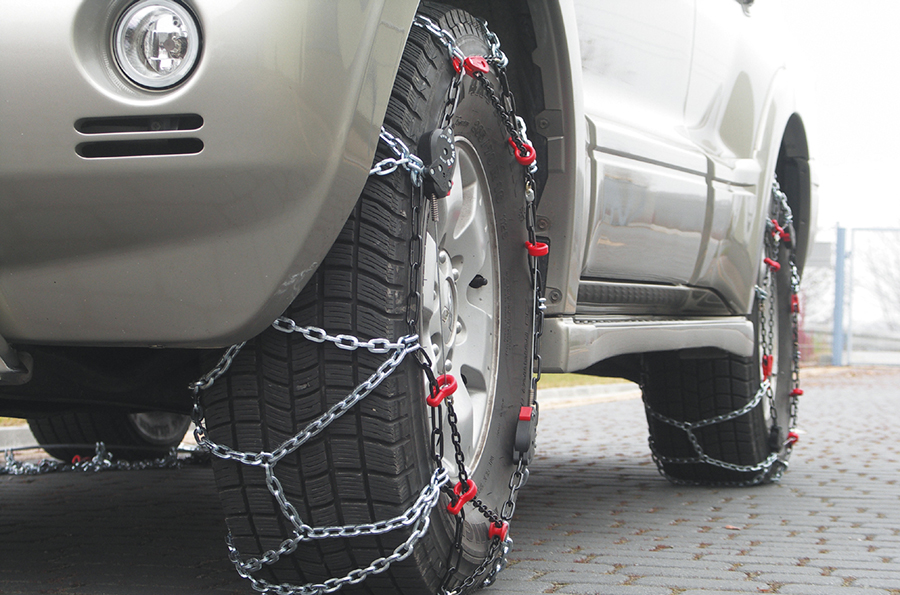
Pull Out Chains & Instructions. With your vehicle parked, open the bag and pull out your instructions and your first chain. Each bag comes with two chains. The plastic instruction mat that comes with your chains can be used as a barrier between you and the snow to keep you dry.
Untangle Your Chains. Holding them from the plastic-covered cable, make sure everything is straight and the chains are not looped over one another. Hold up your chains so the yellow end is in your left hand and the blue end is in your right.
The chains should hang loosely and the metal hooks seen along the yellow and blue sections should be facing away from you so they don’t damage your tires.
Place Chains onto Your Tire and Connect the Cable. Lay your chains on the ground and push them behind the tire, yellow cable end first, from the right side to the left.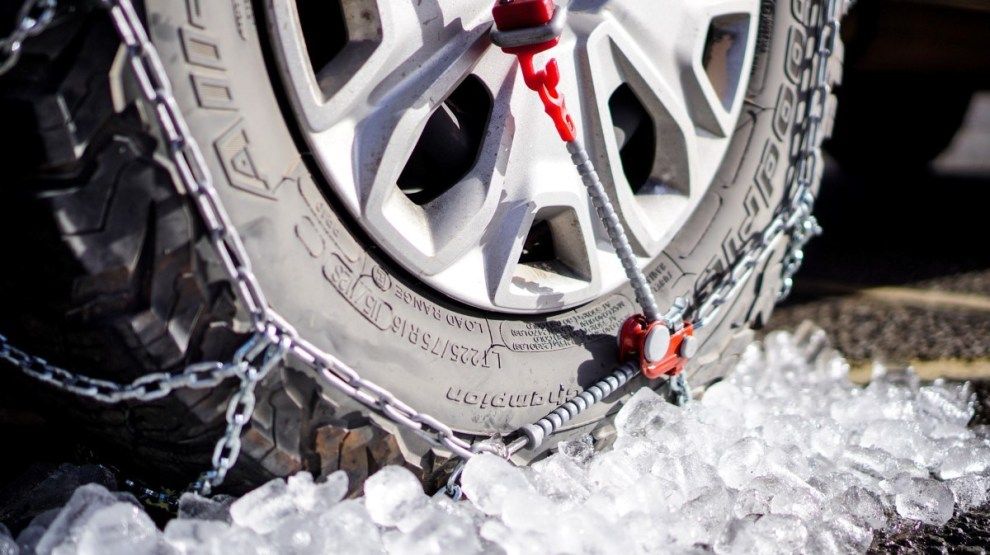
Once the chains are centered behind the wheel, grab both ends and pull them up over the top of the tire. You should feel the chains against your axle.
This will allow you to easily connect the yellow and blue ends of the cable by slipping one end into the other and pulling them into place.
Connect the Red Hook. Now that the cable is connected on top, look for the red hook directly opposite the cable connection. Connect the red hook on the right to the first available gold link on the left.
Check the Diamond Shape. Push the connected chain over the top of the tire. You should see the diamond shape in the chains against your tire. Between each of those diamonds is the center rail, which should be placed down the middle of the tire tread.
Connect the Red Chain Along the Bottom. Now that the cable is connected on top, look for the red hook directly opposite the cable connection. Connect the red hook on the right to the first available gold link on the left. Push the connected chain over the top of the tire.
Now that the cable is connected on top, look for the red hook directly opposite the cable connection. Connect the red hook on the right to the first available gold link on the left. Push the connected chain over the top of the tire.
The bottom of the chains includes a red draw chain with bungee on your right, and a chain guide on the left. Pull these out towards yourself.
Take the long red chain and run it through the chain guide and pull as tight as you can with both hands. Don’t pull using the bungee. As you pull, one of the chain links will find its way into the notch on the red chain guide, locking it into place.
Using the bungee end of the red chain, pull it through one or both of the red loops and secure it to a gold-side chain opposite the red loops. If you can’t get it through both loops, that’s ok, pull tight through one and attach it to a side chain to the left of the loop.
Repeat on Second Tire. Repeat these steps to install chains on the other side of your vehicle.
Repeat these steps to install chains on the other side of your vehicle.
Drive Forward Slightly. The next step is to drive forward about 15 feet, or a full car length. This gives the chains a chance to relax and settle on your tires.
Re-tighten Chains. To take up any slack, unhook the rubber end of the red draw chain and pull it tight again. Once it’s tight, guide the red chain through the loops and, again, securely latch the bungee end to the gold-side chain.
The chains should be tight on the tire. And, be sure to stop if you hear them making any contact with your vehicle. If your chains are still loose, unhook the bungee and adjust the red hook straight across from the chain guide. Unhook and reattach to the tightest position on one of the three gold chain links. It’s okay if the extra links are hanging loosely. Now, you’re ready to reattach your bungee.
While driving with tire chains, listen for a loud sound of slapping, or metal on metal. If you hear any indication that a chain may be broken or hitting your car, STOP as soon as safely possible. Loose or broken chains that flap can wrap around a strut or shock component, causing big damage to your vehicle. To help prevent damage, here are a few tips for driving when you have winter chains installed on your vehicle.
Pull over in a safe location and remove the chains. Start by unhooking the bungee and chain from the guide, removing them from the tensioner. Unlatch the red hook, and then undo the blue and yellow cable connection. Once all of your chains are off and lying flat on the ground, pull backward or forward slowly a few feet so you can safely pick them up.
At the end of your trip, lay your chains out in the garage and let them dry. If you pack them wet, they can rust.
Also check them for wear, especially if you’ve driven them on asphalt for any distance. Look for flat spots, and replace the chains if you find some.
Link at left shows flattening from wear. Link in center shows sharp edge from wear that can damage a tire.
Remember, if you don’t use your chains all winter long, you can return them with proof of purchase to any Les Schwab for a full refund in the spring.
Get your next set of Quick-Fit chains, along with a few tips on how to install them, at your local Les Schwab, where doing the right thing matters.
Want more tips on winter road safety? See 19 Winter Driving Resources You Can’t Do Without.
Get More Winter Tips
Aquiline Tire Chain Installation InstructionsAquiline Tire Chains provide traction solutions in the most demanding conditions for truck, tractor, grader and loader applications. Installing chains for severe weather conditions.Installing today's snow chains is a fairly simple procedure, but it's a good idea to practice a little. Be sure to do a dry run before the weather gets bad so that you will understand how the chains fit on the tires. If you have never driven on tire chains before and you can find softer ground, such as a dirt road, a test drive with chains installed can prepare you for the differences chains make on your car. Chains on the back wheels will limit your steering somewhat, while chains on the front wheels can cause your car's rear-end to react irregularly. Snow Chain Guidelines
Which chain size do you need for your vehicle?The easiest way to determine which size chains you need is to look at your tires. Whether you’re looking for chains for a car, truck, tractor, ATV, or whatever, every tire should be stamped with its size on the sidewall. To purchase the correct size, chains should have matching specifications to the tire. For the size 255/70R15 the numbers refer to;
The wrong size chains can and will damage the sidewalls of your tires.This could cause a blow out of the tire and be instrumental in an accident. At the very least, it can cause frustration and inconvenience. Avoid renting chains as usually these are a one size fits all type of chain. As with having the wrong size, these too can cause damage to your tires. Many low-profile cars do not have the clearance for chains between the fender and the tire itself.Before purchasing any chains, be sure your car and tires can accommodate them. Also, check with your local officials to make sure that chains are allowed in your area, some municipalities require the use of snow tires instead of chains. Please refer to our article regarding state tire chain laws. Tire Chain FAQ'sWhat are tire chains?Sounds like an obvious question but it's one we get asked. Can you give me advice on how to put on tire chains?Our install page here: Installing Tire Chains gives advice and tips on how to install your chains, and most of our chain pages have an instructional how-to video at the bottom of the page as well, but if you can't see what you need then visit our youtube channel page for more instructional videos. What size tire chains do I need?Our helpful guide on our install page here: How to size chains gives you instructions on how to find the right chain to fit your tire. If you are looking for a chain to fit your ATV then contact us at (866) 437-5883. What advice can you give for driving in snow?See our page here: Driving in the snow for information about how to drive safer in snow and ice. Where to buy snow chainsWe ship internationally to most places, and shipping in the US is free, but if you are in the vicinity of Cedar Rapids, Iowa you can come by and purchase from our warehouse based at Cedar Rapids Tire. How much are snow chains?That pretty much depends on the vehicle you are driving and the style of chain you are looking for. Cable-based chains are usually cheaper than the heavier, and as a result stronger, linked chains. Chains designed for use on cars are also far cheaper than the large bulky chains used for tractors, graders, and other similar-sized vehicles. |
What to do if a group of comrades goes to “that interesting path that they didn’t manage to pass last time”, and there are already winter galoshes on the car and there is neither time nor time to change them for MT boots wishes? Of course, look for ways to improve the characteristics of what is and do it with minimal nervous costs.
Somewhere in the trunk, I'm sorry, in the back of a Ford Ranger pickup, there was a set of car chains “quite by accident”. Why not try to test them?! We tried it on the snow, now we'll try it in the mud, and sometime later we'll test it in other conditions, and in comparisons.
In general, a pickup without locks and a winch, on 16 rims, 32-inch winter tires, and around the corner waiting for a group of friends, among whom there is a place for cars with mud slippers and a couple of winches. Yes, just in case.
Yes, just in case.
Failed to find a known track. More precisely, it turned out, but the "negligent" road builders managed to fill it with asphalt chips and make a civilized passage. It turned out to be the case when the presence of a good road got "across the throat" of car addicts, but we are not offended.
Frustrated by the lack of adventure, we look at the map. There is a lake and a forest nearby, and the idea is already spinning in my head to make a sightseeing trip around a natural mirror; the presence of a dam and a possible ford begins to warm the soul with the prospect of a fun walk in the fresh air. Within a few minutes, when TagAZ Tiger, who had gone on reconnaissance, sat up to his ears, everyone realized that it was time to play off.
Snow chains do not need to be deflated to fit - chains are used on tires with normal working pressure. I, for the sake of the purity of the experiment, installed chains only on the rear axle and ... turned off the front axle.
In the same place where five minutes ago the car categorically protested against moving forward in all-wheel drive, with chains on and a drive only to the rear axle, it confidently crawled forward. Cars following were struggling with the treacherous clay. Some participants periodically took out shovels and slings, and Ford with chains confidently rolled along the rut.
Seeming permissiveness turned out to be no less insidious than local soils - the "passability of the chains" ended as quickly as the pickup's clearance. The connection of the all-wheel drive did not change the situation, and it was no longer useless to knead the porridge with iron. This, however, was to be expected. A reliable sling was removed from the body and ...
I had a feeling of deja vu - last winter we already tried the chains in action. Then, in the deep snow on the field, the chains put on the tires helped to row forward exactly as long as there was enough ground clearance. Having driven a similar pickup truck on MT rubber into the same field, we got a similar effect.
You can't call it a failure. No matter how good tires are on the car, adventures always begin where the space under the bridges or the belly of the car ends. The chains, although they give the feeling of riding on tracks, but this is exactly the feeling.
There was a ford ahead, which turned out to be a water-filled ravine with a slippery clay exit on the other side, which complicated the task. I go out to storm the "ditch" first and the pickup, slowly turning the wheels, confidently climbs up the hill.
From the side it even seemed that the hill did not represent any ambush. Next came the Patriots with a more toothy AT and MT tread, which took the obstacle, but not in tension, but in motion. It was possible to compare the behavior of studded winter tires only with Land Rover Discovery 3.
The discar confidently climbed up the hill and... rolled back. Neither the famous Terrain Responce, nor the imitation of blocking helped. Disco 3 was able to cross the hill only on the third try. We put a test on the car, but the tires are unsuccessful, but that is exactly what was to be expected.
We put a test on the car, but the tires are unsuccessful, but that is exactly what was to be expected.
The discar was only moving at all thanks to the efforts of English engineers, and in some places the audience was surprised how he crawled forward at all if all four wheels were slipping. It helped that the zamylenny winter tire tread did not dig, but yelled somewhere on the surface of the clay, plus the air suspension gave a good supply of space from below.
For the purity of the experiment, I had to slide into the ditch again and ... calmly get out of it, which caused a storm of indignation from my colleagues and accusations of unsportsmanlike behavior, but the chains unanimously received a "set-off".
It was decided to celebrate a successful journey around the lake with hot tea on the shore. As a table, of course, the tailgate of a pickup truck. Getting down to the water on a gentle slope is not a problem. There is also an opportunity to wash the chains in water and not drag the clay home.
When it was time to go home, Ford not only refused to go up, he also strove to slide into the water, apparently not wanting to go out in a dirty state. And all this on a "childish" slope, when quite recently he stormed a serious clay hill without any effort.
This is where a friend's winch comes in handy. We must pay tribute that it came in handy for the first time in the entire trip to evacuate the experimental pickup truck. Isn't this a positive assessment of auto chains that were already clean in the back?!
Active citizens of OffRoadClub.ru took part in the sortie, so it’s worth asking their opinion on the agenda item:
Alexey | ||
| kruzenwtern
Russia, Moscow Off-road experience: 7 years I drive UAZ03Z-5Z-14 Pickup (2008+14) | ||
Undoubtedly, a useful and irreplaceable thing in the household.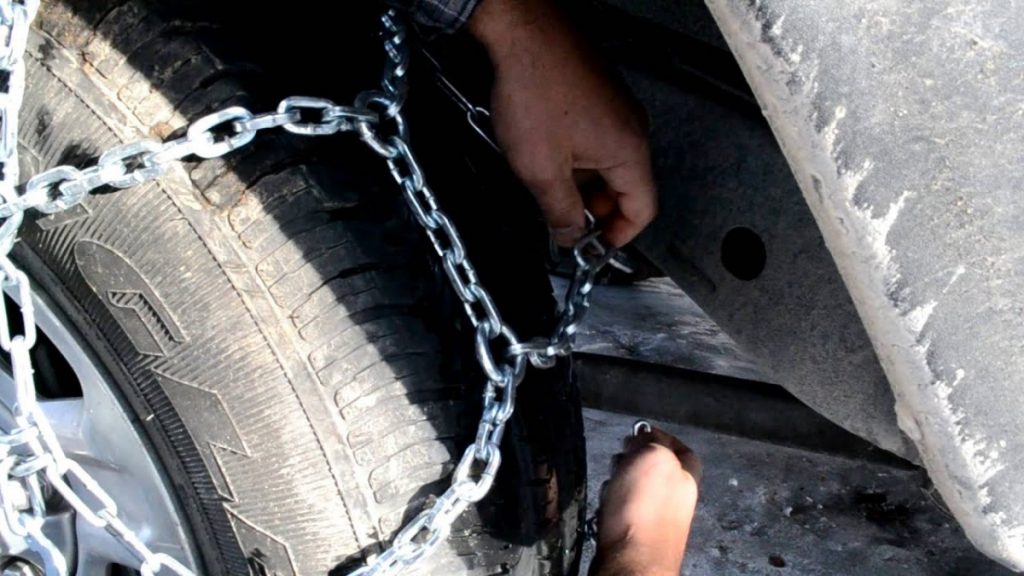 It's just an off-road cheat device. With chains, even the classic Zhiguli will turn into an all-terrain vehicle.
It's just an off-road cheat device. With chains, even the classic Zhiguli will turn into an all-terrain vehicle.
Of course, they also have drawbacks - if you handle gas carelessly, you can very quickly dig in or damage something on the car. So with chains on wheels, you don’t have to rush and generally forget about some things that are permissible during normal driving.
For owners of SUVs and crossovers who do not want to buy tires with off-road tread, it is highly recommended to keep the kit in the trunk. If there is a trunk at all, then a place for chains can always be found.
And one more piece of advice - put on the chains in advance, otherwise putting on the chains after driving into the "puddle" is a very inconvenient and dirty thing.
Vyacheslav | ||
| multik
Russia, Moscow off-road experience: 5 years | ||
For a long time I treated chains with disdain: they say, in most cases it takes a long time to put them on or it’s too late, and if you inadvertently press the gas pedal, you instantly start digging a well to the center of the Earth .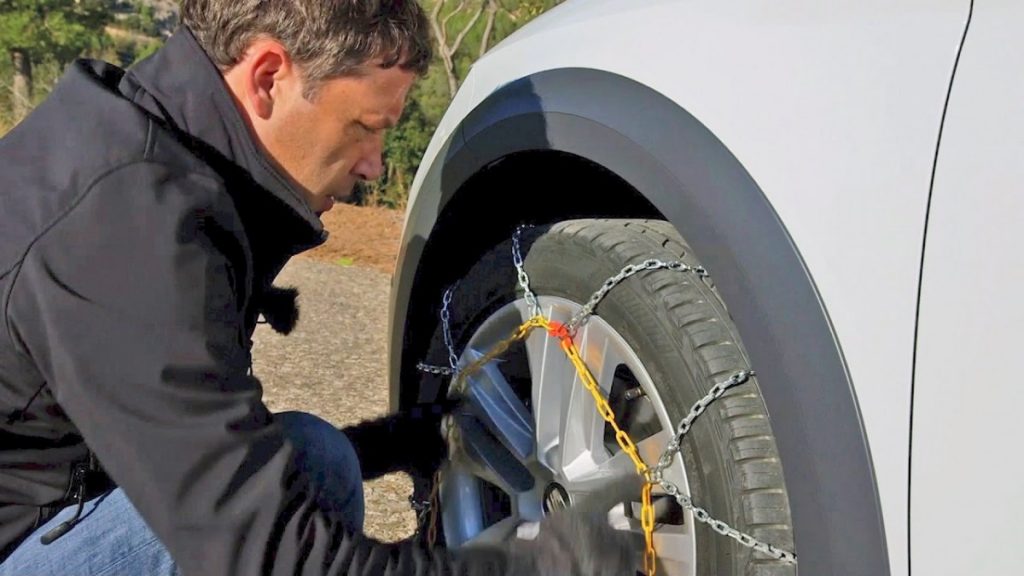 .. Mud tires are much better: they ride and always with myself.
.. Mud tires are much better: they ride and always with myself.
However, the test started to change my attitude towards chains. Where cars on mud tires passed “on the move”, a car on chains drove defiantly and defiantly slowly. And this is on sticky clay, where all my experience literally screamed about the need to spin the wheels for self-cleaning!
Upon arrival home, I literally watched the video frame by frame, where the car was captured on chains, because everyone wanted to catch the moment when the wheels with chains begin to slide. Didn't catch. As a result, I am now thinking about only one thing: to take a "ladder" or "honeycomb".
Pins
Snow chains - be! Road tires with chains on turn into “smart mud tires” and can outperform the classic MT tires in places.
Don't expect a miracle - the flotation of a car with chains on wheels improves as much as ground clearance allows. No one has repealed the laws of physics, and a car that has sat on its belly also starts rowing its wheels uselessly in the air, as it would do on good rubber.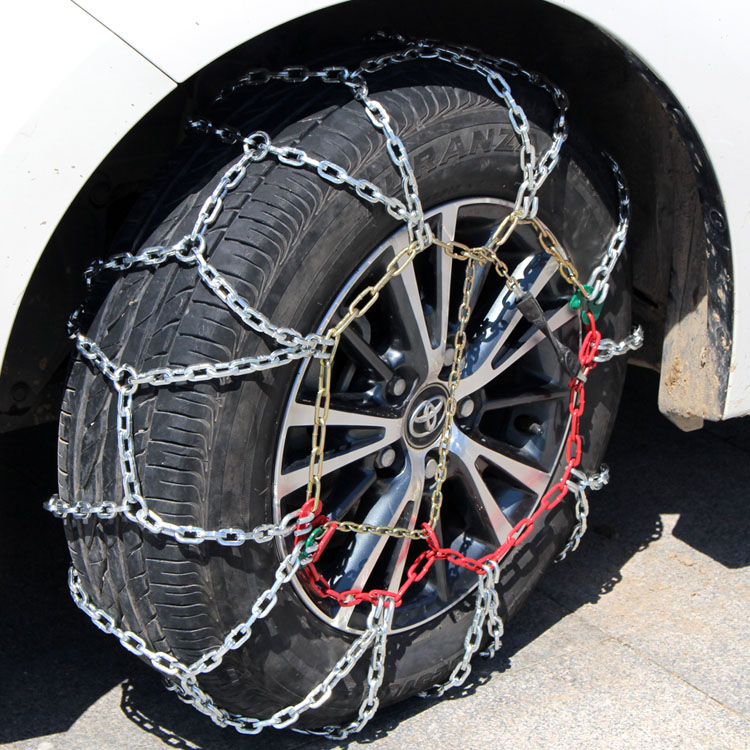
Snow chains are rated "FOR" for:
- Improved tire performance in both summer and winter conditions, especially on slippery slopes.
- Low acquisition cost.
- No need to have a set of off-road tires for one-off off-road trips. At the same time, only chains will save on an icy slope, and no MT-shnaya or studded tires will help.
"NEG" ratings deserve:
- The need to put on and take off the chains when leaving the asphalt and leaving it, while not always clean and warm.
- The relatively high weight of the chains and the need to transport them in the trunk, and after use, possibly dirty.
- Decreased vehicle speed.
Personally, I came to the conclusion that having a set of snow chains in the garage is not a whim, but quite a meaningful act, even if it can be used once or twice a year. Chains do not deteriorate and with proper care will last for many years.
The advantages and the need for good mud tires remain the same. Chains can either replace it for one-time trips to nature, or become a good addition to a set of road tires when toothy slippers are stored for seasonal storage.
Chains can either replace it for one-time trips to nature, or become a good addition to a set of road tires when toothy slippers are stored for seasonal storage.
We thank the Avtotsep company for the chains provided for the test.
Snow chains on wheels ten
Off-road vehicle owners will need chains to prevent wheel slip when competing. Thanks to this special equipment, you can pull the vehicle out of the mud without the involvement of outside help. Alta-Carter online store offers... read more
Off-road vehicle owners will need chains to prevent wheel slip when competing. Thanks to this special equipment, you can pull the vehicle out of the mud without the involvement of outside help. The Alta-Carter online store offers car snow chains for all types of off-road vehicles.
Our catalog contains spare parts of well-known brands RIF, Avtotsep and Tplus. The kits include 2 pairs of chains, as well as a storage bag and installation instructions. Products differ in section and link height, so it will not be difficult to choose a suitable spare part for wheels with certain parameters.
Products differ in section and link height, so it will not be difficult to choose a suitable spare part for wheels with certain parameters.
You can also purchase the anti-skid bracelet as a single piece or in a set of 6 pieces. They are no less comfortable when used in off-road conditions.
You can buy snow chains for trucks in Alta-Carter in one of the following ways:
